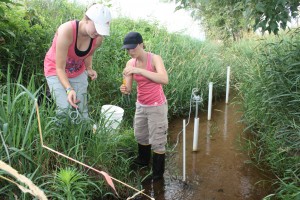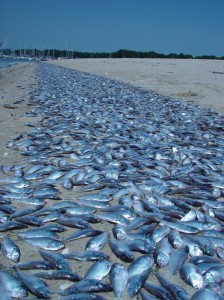by Kristen Minogue

Intern Ginny Leviton (left) and Vienna Saccomanno sample groundwater from a drainage ditch, trying to pin down the exact spot where the nitrogen goes missing. (Credit: Tom Jordan)
The Choptank watershed has SERC researchers baffled. On the eastern shore of Chesapeake Bay, roughly a 75-minute drive from SERC, the groundwater flowing into the Choptank River passes through a cornfield – a likely source of nitrogen, a nutrient that can wreak havoc on the Bay’s ecosystem if it runs too high. But something is happening to the nitrogen here before it reaches the Bay. Nutrient ecologist Tom Jordan and his research team have spent the better part of a year trying to figure out what.
Plants depend on nitrogen to grow and thrive, so farmers often fertilize their crops (and homeowners their lawns) with heavy amounts of it. But some of the nitrogen in the fertilizer gets converted to nitrate (NO3), which can’t bind to the soil and thus goes straight into the groundwater. Once nitrate reaches the Bay, it fuels massive algal blooms that – while good for the algae – block light to the plants underneath them and drain oxygen from the Bay as they decay. This has led to the formation of dead zones in Chesapeake Bay, places where the oxygen is so low that fish and shellfish cannot survive.

Menhaden fishkill in Greenwich Bay, Rhode Island. Too much nitrogen in the Bay can lead to disastrously low levels of oxygen – which in turn can cause massive fish die-offs like this one. (Credit: Chris Deacutis)
However, often only a small fraction of the human-generated nitrogen that goes into a watershed actually comes out of the rivers and streams at the end. Between 10 and 30 percent, according to Jordan. The fate of the other 70 to 90 percent – “missing nitrogen” – is a mystery researchers are still trying to unravel.
Some of it could escape into the atmosphere. Microbes in the soil could do this through denitrification, a naturally occurring process that gradually transforms nitrate into harmless nitrogen gas. Jordan’s lab suspected this also could be happening at Choptank.
Last fall the team began sampling a 1.2-kilometer stretch of the Choptank groundwater at a drainage ditch near the cornfield. Using a collaborative National Science Foundation grant with the University of Maryland, they measured the amounts of nitrate and nitrogen gas entering and leaving three different segments of the ditch. Their findings confirmed the same trend researchers have noticed in other watersheds all over the world: There’s more nitrogen going in than coming out. They also found traces of nitrogen gas at concentrations higher than what they would have expected if the water were in equilibrium with the atmosphere, a clear indication that denitrification was going on in the groundwater. They just didn’t know what was causing it.
This summer one of Jordan’s interns, University of Georgia undergraduate Ginny Leviton, took a more detailed look at the drainage ditch. Leviton sampled groundwater emerging through the ditch sediments at 39 different locations, hoping to pinpoint the exact “denitrification hotspots” that could offer clues as to the fate of the missing nitrate. However, her preliminary findings yielded surprising answers that added another layer to the mystery.
Leviton discovered four nitrate spikes along the groundwater, where the nitrate concentrations shot up and then abruptly plunged back down. However, the two largest nitrate spikes weren’t anywhere near the crop fields, the most obvious source of nitrate pollution in the area. In fact, they weren’t close to any typical sources of nitrate at all. The land around them was fallow, except for a tangled overgrowth of grasses, thorns and blackberries.
Jordan, Leviton and the other lab members have tossed around several hypotheses that could explain the strange data. The nitrate could be a remnant of an old farm that may have stood there in the past. No one has calculated the exact age of the groundwater; it could have been sitting beneath the surface for up to 50 years. Irrigation systems also could have altered the water flow, causing nitrate to appear in places it otherwise wouldn’t.
As for the high degrees of denitrification, Jordan suspects these spots may indicate flow pathways that pass slowly through soils that can support denitrifying microbes. Why these pathways reach the ditch where they do, though, remains an open question.
For now Jordan’s lab plans to follow up on the next round of questions: Exactly how old is the groundwater beneath the Choptank, and how does it flow? Following the groundwater backwards from where it emerges in the ditch may lead them to the hidden nitrogen sinks and sources. When they find out what happened to the missing nitrate, they might learn how to flush out more of it before it further endangers life in the Chesapeake.
Read more: Hunt for a Missing Nutrient, Part II


Any chance that the area where the nitrogen spiked was covered with nitrogen fixing plant species?
Is there a natural wetland that can be discharging anoxic groundwater to the same drainage ditch? See Phillips, Denver, Shedlock, and Hamilton. Wetlands 13(2) 1993, pp.75-83.
An undetected pile or remnant/legacy pile of leaching poultry manure sure could cause the unexpected spike.
Could it possibly be that the overgrowth surrounding the drainage ditch could be taking the nitrogen from the water for plant growth through photosynthesis and cellular respiration. please take note that im only a 15 year old freshman in biology